JAN KUREK
TOMASZ WYDRO
THE MINING OF IGNEOUS ROCKS – MINING TECHNOLOGY EXEMPLIFIED BY THE “ZALAS” PORPHYRY MINE
The geological structure and rock resources of the region of Krakow are very diverse. This results from its location at the junction of three structural units as well as from the variety of geological processes that have taken place during their geological history. Devonian to Quaternary formations are visible on the surface, while the rocks found in boreholes are even older.
Igneous rocks in the region of Małopolska (Lesser Poland) are concentrated in a relatively small area. The following rocks have been mined in the past: red porphyry in Miękinia, melaphyre in Regulice, porphyry in Orla. Currently active mines – quarries, which are engaged in continuous exploitation, include the “Zalas” Porphyry Mine in Zalas and the „Niedźwiedzia Góra” Diabase Mine in Tenczynek.
https://doi.org/10.7494/miag.2022.3.551.7
PIOTR KULINOWSKI
DIRECTIONS FOR REDUCING THE ENERGY CONSUMPTION OF MINING BELT CONVEYORS
The article discusses the issue of energy savings in the operation of mining belt conveyors. Using the concept of energy consumption indicators, the directions for reducing the energy consumption of belt conveyors are presented by applying energy-efficient components, upgrading the drive system, or introducing organizational and technical changes in the conveying process.
https://doi.org/10.7494/miag.2022.3.551.21
ZYGMUNT ZUSKI
THE CREATION OF A NEW TRANSPORTATION ROUTE NEAR THE CRYSTAL GROTTO IN THE “WIELICZKA” SALT MINE THROUGH THE CONSTRUCTION OF A FORE-SHAFT EQUIPPED WITH A TRANSPORTATION DEVICE
This article presents the planned fore-shaft construction between the 2nd upper and 2nd lower levels equipped with a hoisting device for materials transportation. The main aim of this venture was to create a means of transporting materials used in the process of protecting and maintaining the Crystal Grotto. There is currently no vertical connection between the 2nd upper and 2nd lower level. As a result, all material transportation is performed manually over the incline paths.
https://doi.org/10.7494/miag.2022.3.551.35
BEATA BORSKA DAWID SZURGACZ JAN GIL
DEVELOPMENT OF A CHARGING SYSTEM ENSURING THE LOAD-CARRYING CAPACITY FOR POWERED ROOF SUPPORT
The powered roof support is an essential part of the protection of the mining wall. Its main task is to support the roof of the wall excavation and, as such, it must resist the coal mass that has the potential to collapse the mining pit. The force with which the powered roof support acts on the roof of the excavation is called load-carrying capacity. This paper describes the problem of the load-carrying capacity of powered roof support, in particular reviewing their charging systems. The research aims to ensure that the re quired initial load-carrying capacity is obtained and the working load-carrying capacity is maintained. This paper presents the research results of a double-block prototype equipped with an automatic charging system. We present the results of both bench and operational testing in real conditions.

